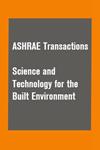CFD modeling of room airflow effects on inactivation of aerosol SARS-CoV-2 by an upper-room ultraviolet germicidal irradiation (UVGI) system
IF 1.7
4区 工程技术
Q3 CONSTRUCTION & BUILDING TECHNOLOGY
Science and Technology for the Built Environment
Pub Date : 2023-08-09
DOI:10.1080/23744731.2023.2247947
引用次数: 0
Abstract
Ultraviolet germicidal irradiation (UVGI) systems inactivate microorganisms indoors. Upper-room UVGI systems use wall- or ceiling-mounted fixtures to create an air disinfection zone above the occupied zone. The performance of upper-room UVGI systems varies with indoor airflow patterns induced by mechanical ventilation and thermal plumes from indoor heat sources. Little information is available on the effects of ventilation strategies on upper-room UVGI system performance for the control of viral aerosols in occupied spaces. This study simulated the effects of ventilation system characteristics in an office space on the ability of an upper-room UVGI system to inactivate viral aerosols with UV-C susceptibility representative of coronaviruses. UVGI reduced viral aerosol concentration by two orders of magnitude relative to the concentration without UVGI. Air change rates and air distribution strategy (mixing vs. displacement) had notable effects on the effectiveness of the UVGI system. For mixing ventilation, as the recirculation airflow rate increased from 0 to 5.3 h−1 for a room volume of 108 m3 with a fixed outdoor air change rate of 0.7 h−1, UVGI inactivation increased by 96.7%. Mixing ventilation with 100% outdoor air of 0.7 h−1 yielded airborne virus inactivation that was double that of displacement ventilation, due to enhanced air mixing.室内气流对上室紫外线杀菌照射(UVGI)系统灭活气溶胶严重急性呼吸系统综合征冠状病毒2型影响的CFD建模
紫外线杀菌照射(UVGI)系统使室内微生物失活。上层房间UVGI系统使用墙壁或天花板安装的固定装置在占用区域上方创建空气消毒区域。上层房间UVGI系统的性能随机械通风和室内热源产生的热羽流引起的室内气流模式而变化。关于通风策略对上层房间UVGI系统性能的影响,用于控制占用空间中的病毒气溶胶的信息很少。这项研究模拟了办公空间通风系统特性对上层房间UVGI系统灭活具有代表冠状病毒的UV-C易感性的病毒气溶胶的能力的影响。相对于没有UVGI的浓度,UVGI将病毒气溶胶浓度降低了两个数量级。换气率和空气分配策略(混合与置换)对UVGI系统的有效性有显著影响。对于混合通风,随着再循环气流速率从0增加到5.3 h−1表示房间容积为108 m3,室外固定换气率为0.7 h−1,UVGI灭活增加96.7%。混合通风与100%室外空气0.7 由于空气混合增强,h−1产生的空气传播病毒灭活是置换通风的两倍。
本文章由计算机程序翻译,如有差异,请以英文原文为准。
求助全文
约1分钟内获得全文
求助全文
来源期刊

Science and Technology for the Built Environment
THERMODYNAMICSCONSTRUCTION & BUILDING TECH-CONSTRUCTION & BUILDING TECHNOLOGY
CiteScore
4.30
自引率
5.30%
发文量
78
期刊介绍:
Science and Technology for the Built Environment (formerly HVAC&R Research) is ASHRAE’s archival research publication, offering comprehensive reporting of original research in science and technology related to the stationary and mobile built environment, including indoor environmental quality, thermodynamic and energy system dynamics, materials properties, refrigerants, renewable and traditional energy systems and related processes and concepts, integrated built environmental system design approaches and tools, simulation approaches and algorithms, building enclosure assemblies, and systems for minimizing and regulating space heating and cooling modes. The journal features review articles that critically assess existing literature and point out future research directions.
 求助内容:
求助内容: 应助结果提醒方式:
应助结果提醒方式:


